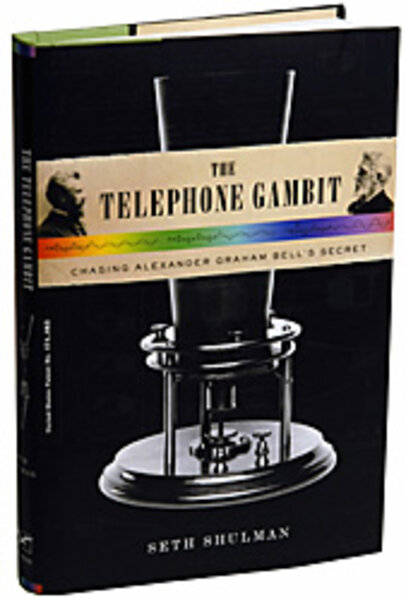Sorry, wrong inventor
Loading...
How often does a detective story upend history? Probably about as often as a science and technology journalist pens a page-turner. But with this month's release of The Telephone Gambit by Seth Shulman both these unlikely events are coming to pass at the same moment.
This slender volume (252 pages, with notes and credits) is a work of nonfiction – although the strangeness of truth definitely overtakes fiction here as Shulman explains how he unraveled Alexander Graham Bell's claim to have invented the telephone. We may never be absolutely certain, but "The Telephone Gambit" presents compelling evidence that Bell snuck a look at rival inventor Elisha Gray's patent application, stole a crucial element from it, and then lived an uncomfortable lie for the rest of his days.
This is not the work of a muckraker. No one wanted to reach such a conclusion less than did Shulman, a longtime admirer of Bell's. But that's exactly why this book is such a good read. Shulman carefully spells out not only the steps he took to piece together his story, but also the reluctance he battled en route.
Why would Bell – a man whose good character was noted by all who knew him – behave so dishonorably? How could he have stolen from a rival he had never met? And is it even possible that such a high-profile crime could have gone undetected for so long?
The answers to these questions unspool neatly throughout Shulman's narrative but they read more like the stuff of thrillers than of the history of science. Figures in this real-life drama include (it would seem) an alcoholic patent clerk, some unscrupulous attorneys, and a beautiful young woman whom Bell yearned to marry.
Shulman's first glimpse of the story came in 2004. He was enjoying a yearlong research fellowship at the Dibner Institute for the History of Science and Technology at the Massachusetts Institute of Technology. There, he was studying recently digitized reproductions of the private papers of Bell. Shulman was thrilled to be able to follow so close on the heels of his hero – yet puzzled by something he saw.
Shulman knew the story of the invention of the telephone as well as anyone – or at least he thought he did. Alexander Graham Bell and Elisha Gray filed patent applications on the very same day in 1876.
(Gray's was actually a "caveat" – but it would have served the purpose of staking Gray's exclusive right to continue research in this area.)
According to the official story, Bell filed a few hours earlier than Gray and so was awarded the patent. Then, the next month, he had the breakthrough moment we've all read about in the history books. (After spilling acid in his lab, Bell shouted, "Watson, come here, I need you." Watson, in another room, heard him through the device they were experimenting with and thus was born the telephone.)
Or so we've always believed.
But what troubled Shulman was that Bell's "eureka moment" depended on an element that had been completely missing from Bell's research until only two days earlier. Then, this crucial link suddenly appeared in Bell's journal in a sketch remarkably similar to a drawing found in Gray's patent application. In the days just before this sketch appeared, Bell had not been working in his lab. On the contrary, he'd been in Washington, filing his patent claim.
I won't spoil the fun (and it is fun) by explaining exactly how Shulman proceeded and what he discovered as he worked backward from that point. Bell, he ended up concluding, was a great innovator who had made much progress toward the telephone, but he is not its creator. Instead, it seems, he was a talented, decent man, who lived with guilt ever after being pressured into an unseemly act of theft.
Shulman does a neat job of painting, in rapid brush strokes, a portrait of the thrilling era of innovation in which Bell lived and also of the interesting circumstances of his life. (His speech professor father was the real-life model for the Henry Higgins of George Bernard Shaw's "Pygmalion.") Shulman also manages to lace his work with just enough technology to tell his story without losing the interest of any low-tech readers.
As a result, "The Telephone Gambit" succeeds splendidly as an edge-of-your- seat historical tale. Yet it also manages to go somewhere deeper, leaving readers with intriguing questions about the ways in which truth may remain undiscovered, even when lying open in plain sight.





